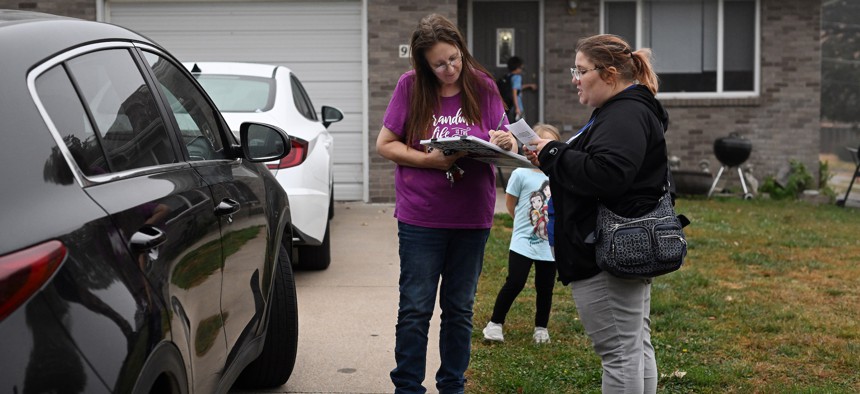How paid sick leave helps cure economic instability

Sierra Edmisten (right) watches as Katherine Garland signs a petition to get paid sick time for all employees working in the state of Nebraska, where advocates hope to see the initiative on next year's ballot. In the absence of a national standard, cities and states are enacting paid sick leave legislation, a policy that mostly affects low-wage workers. Joshua Lott/The Washington Post via Getty Images
Cities and states are enacting paid leave policies that prevent low-wage workers from choosing between rest and recovery or work and a paycheck.
When low-wage workers get sick and miss a day of work, they might have trouble covering their electricity bill. If they miss five days of work, that cuts into their food budget. And eight missed days could be the equivalent of a month’s rent.
That’s according to a recent report from the Economic Policy Institute looking at access to paid sick leave among low-wage workers. The share of low-wage workers who can earn paid sick leave has doubled over the last decade, largely thanks to state- and local-level paid sick leave mandates, according to the report. These policies typically grant workers an hour of paid leave for every 30 to 40 hours worked, according to the report’s co-author Hilary Wething.
Paid sick leave mandates ensure workers “don't have to make the impossible choice between showing up to work sick or losing pay,” Wething said.
Nationwide, 78% of workers have access to paid leave, up from 63% in 2010. But for the workers who fall within the lowest 10% of the wage distribution, that figure drops to 39%.
There is no national standard for paid sick leave, but many cities and states have shaped their policies around legislation that has been repeatedly introduced in Congress. The Healthy Families Act would allow workers in businesses with more than 15 employees to earn one hour of leave per 30 hours worked, or up to seven days per year. The act was first introduced in 2004 and most recently in May, but it continues to flounder.
In a perfect world, a national standard would ensure everyone has access to leave, Wething said, but in the meantime, it's up to cities and states. Over the last several years, 15 states and Washington, D.C., passed paid sick leave mandates, as have 17 cities and four counties. Such laws mostly improve conditions for low-wage workers and have helped increase access to paid leave from only 20% of the state’s lowest-wage workers in 2010 to 39% today.
States are continuing to consider and expand paid sick leave policies. Advocates in Missouri and Nebraska hope to see ballot initiatives mandating paid sick leave on next year’s ballot, and California recently enacted legislation expanding the amount of sick leave employers are required to give workers.
Paid sick leave is an important tool for protecting public health, the report notes. Sick employees who show up to work are not just impeding their own recovery, they’re potentially infecting everyone they come into contact with. For public-facing jobs like grocery store clerks and servers in restaurants, that can amount to a lot of transmission. Research has shown that cities and states with paid sick leave mandates have lower transmission rates for flu-like illnesses compared to those without such laws, the report notes.
While the movement has gained traction over the last several years, many states and communities are resistant to the idea.
“Valuing the benefits of something like community health is pretty tough in that it’s not directly related to [an employer’s] bottom line,” Wething said. It can also be difficult for employers to see the productivity benefits of support for workers’ health until they see it for themselves, she added.
Some worry such policies would increase business expenses, potentially leading to lower wages or reduction of other benefits for workers. But these concerns are generally unfounded, Wething said, as there’s no evidence to show that offering paid leave affects companies’ bottom lines. A 2016 analysis of New York City’s paid sick leave law found that two years after implementation, 85% of employers said the policy did not affect business costs.
The best way to think about paid sick leave “is not as an employer handout but something that workers are earning by their work intensity over time,” she said. “It's that earning and that incremental nature of paid sick days in particular that makes the cost of providing that time much lower to employers.”






